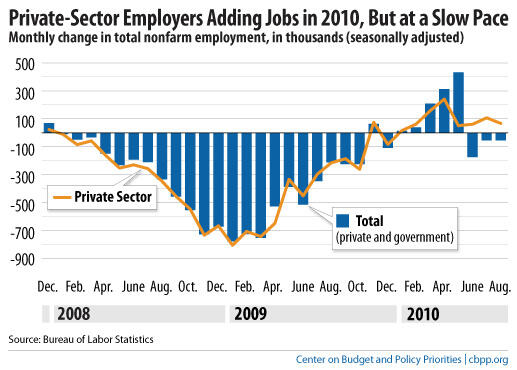Statement by Chad Stone, Chief Economist, on the August Employment Report
Today’s jobs report provided better news than expected about private-sector job creation, but the case for additional stimulus to boost a tepid economic recovery and revive the job market remains strong. The good news, as the chart below shows, is that the economy has now added private-sector jobs for eight straight months. The bad news is that adding fewer than 100,000 private-sector jobs a month, as we have been doing, will not bring down the unemployment rate.
Here are some of the key numbers from today’s report on the August employment situation:
- Private and government payrolls combined fell by 54,000 jobs in August. Private employers on net added 67,000 jobs, but those gains were not enough to offset the decline in government jobs. So far this year, private payrolls have expanded by 763,000 jobs, a pace of 95,000 jobs a month.
- The decline in government payrolls of 121,000 jobs was due largely to the scheduled termination of 114,000 temporary jobs associated with the decennial census. Also, state governments reduced their payrolls by 14,000 jobs (6,000 of those in education). Local government payrolls increased by 4,000 as the loss of 10,000 education jobs was offset by a gain of 14,000 jobs outside education.
- There are 7.6 million fewer jobs on nonfarm payrolls than there were when the recession began in December 2007, and 7.7 million fewer jobs on private payrolls.
- The unemployment rate edged up to 9.6 percent in August, and the number of unemployed rose to 14.9 million.
- A piece of good news on unemployment is that people came back into the labor force looking for work in August after four straight months of declining labor force participation. The percentage of the population with a job also edged up after dropping for three straight months.
- Other unemployment statistics show that it remains very hard to find a job. The Labor Department’s most comprehensive alternative unemployment rate measure — which includes people who want to work but are discouraged from looking and people working part time because they can’t find full-time jobs — edged up to 16.7 percent in August.
- Long-term unemployment remains a significant concern. Over two-fifths (42 percent) of the 14.9 million people who are unemployed — 6.2 million people — have been looking for work for 27 weeks or longer. These long-term unemployed represent 4.1 percent of the labor force. Prior to this recession, the previous highs for these statistics over the past six decades were 26.0 percent and 2.6 percent, respectively, in June 1983.

As I said last week when the Commerce Department report on weak second-quarter growth came out, the economy is still growing but the recovery needs a boost from further monetary — and fiscal — stimulus as soon as possible.
The Center on Budget and Policy Priorities is a nonprofit, nonpartisan research organization and policy institute that conducts research and analysis on a range of government policies and programs. It is supported primarily by foundation grants.
